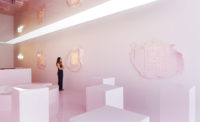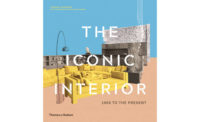A wood-slat egg-shaped pavilion on the beach just steps from the Atlantic may be the most popular art intervention of the Art Basel Miami fair, which closes this Sunday. Commissioned for the fair by Absolut Vodka's "Art Bureau," the lantern-like pavilion comes with an orchestra that plays specially-commissioned music by Joan Valent outside until 11 P.M. Inside is a vodka bar, where bartenders wave martini shakers to the beat of the music.
The open-air structure literally glows in the dark. "We were very surprised when we illuminated it, because the object becomes a lamp," says designer Dagobert Rodriguez of the Cuban artist duo Los Carpinteros. His partner is Marco Castillo; neither are architects. "It's one thing when you are in the studio planning something and another when you see it in life. This is the largest object we've made so far," says Rodriguez.
He originally thought people would enter the pavilion and peek through the wide openings to the wood deck that surrounds it. As it turns out, the people inside are busy partying and it's the crowd outside that looks in. Rodriguez says the inspiration was a circular panopticon prison model that the English social theorist Jeremy Bentham developed in the 18th-century, where a centrally-situated warden could, in theory, survey the prison cells around him. "We are very fascinated by this panoptic system, which is not only beautiful but full of ambiguity and content," says Rodriguez.
Established in 1991, Los Carpinteros are best known for beautifully crafted, irreverent, and often satiric installations at art shows around the world. Their drawings and works are in MoMA, LACMA (Los Angeles Museum of Art) and the Guggenheim. They are based in Madrid but often return to Cuba.
The beach bar also takes its inspiration from the physical world, namely a gourd. It is called "Guiro," the name of an ancient Cuban percussion instrument made from a hollowed out dried gourd. The construction of the elegant pavilion is a tour de force, with wires stabilizing the waterproof marine plywood "staves" of the squat "barrel." "We had it fabricated in Germany; it was an ambitious plan," Rodriguez explains. And will it be demolished after the fair ends? "We don't want to destroy it; ‘Guiro’ belongs to the part of our work which is about spaces for living. We are planning to show it again."
And just in case they don't, you can buy a model of it, one in an edition of five, at the Sean Kelly Gallery at Art Basel, which represents Los Carpinteros.










Post a comment to this article
Report Abusive Comment